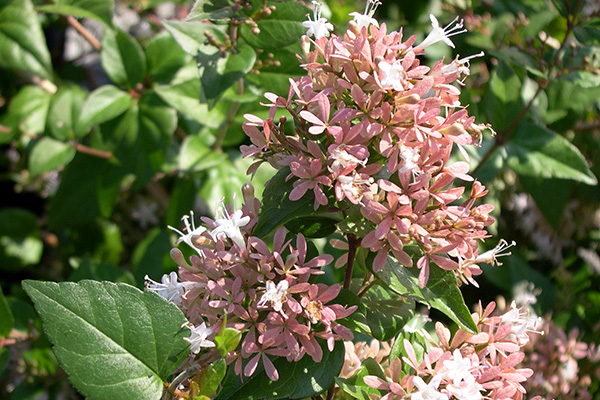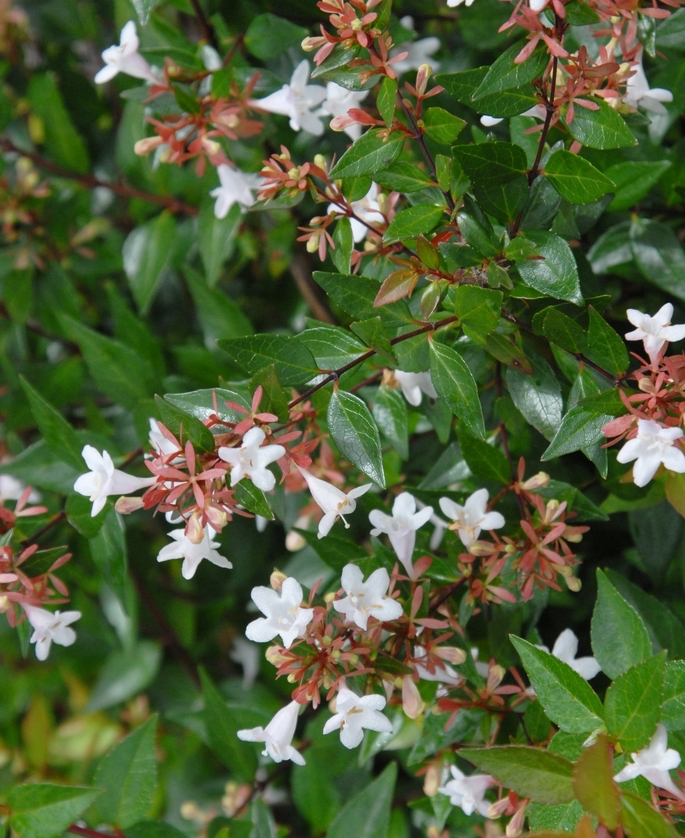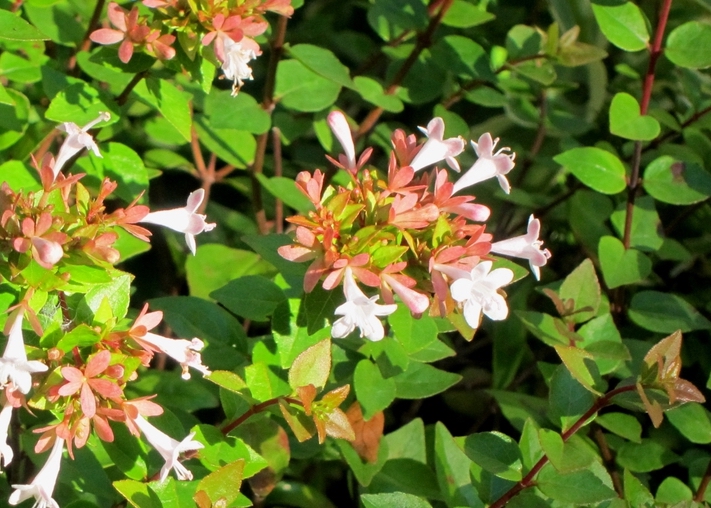Abelia: A Beautiful and Fragrant Addition to Your Garden
By Carolyn R. Casey, Fairfax Master Gardener
Are you looking for a beautiful and fragrant specimen plant to add to your garden? Would you enjoy attracting butterflies and other pollinators to your landscape? Then consider adding Glossy Abelia, one of its cultivars or perhaps Chinese Abelia to your garden.

Linnaea chinensis
Glossy Abelia (Linnaea x grandiflora) is a descendant of Linnaea chinensis, also known as Chinese Abelia, and is a member of Caprifoliaceae, the honeysuckle family. It was named after Clarke Abel, a British naturalist and physician. Abel’s Abelia was introduced to England as a living plant in 1844 by Robert Fortune. Around 1900, Abelia chinensis and Abelia uniflora were crossbred to create Abelia x grandiflora. Glossy Abelia was recently reclassified as Linnaea x grandiflora. Analysis of genetic hereditary differences showed that the genus was not monophyletic (not from a common ancestor). In 2013, Maarten Christenhusz, a Dutch botanist, proposed a merger of Abelia into the genus Linnaea.

Linnaea x grandiflora
L. x grandiflora is a multi-stemmed evergreen to semi-evergreen shrub that has a vase, round or upright shape and exfoliating bark. When new, the foliage is a showy, pink-tinged color, and in the fall, the leaves turn a purple lavender or red burgundy color. Its fragrant clusters of small white trumpet-shaped flowers are 3/4 inch long (2 cm). These flowers bloom from late spring until frost and attract bees, hummingbirds and butterflies. This shrub is heat and drought tolerant and likes full sun to part shade. It prefers acidic soil but adapts to most soil types. Plant it as a hedge, foundation, specimen or barrier plant; it does not require special care. It is resistant to deer and Phytophthora root rot. It is also not bothered by air pollution. This species shrub grows 6 to 8 feet (2 – 2.5 m) tall and wide and is propagated by cuttings. It is not a native plant but has no invasive properties.
Hard pruning rejuvenates L. x grandiflora creating a more dense shrub with more flowers. Since it blooms on new growth during the summer, it is best to prune only one-third of it each spring. The top of the shrub needs to be clipped narrower than the bottom so light can reach the lower foliage. This keeps the plant foliage full all the way to the ground. It is good to thin out the shrub so light can reach the interior foliage and generate branches creating a fuller plant.
Glossy Abelia Cultivars
‘Little Richard’ is a compact shrub 3 feet tall and wide with small white flowers. New foliage is bright red, then turns a glossy vivid green in summer and tangerine-pink in fall. It is a semi-evergreen shrub that thrives in full sun and needs well-drained soil. It can be pruned biennially to maintain a full appearance. Cut the main stem to approximately 6 inches tall.
‘Kaleidoscope’ is also a compact shrub. In 1997, it was found growing in North Carolina as a variegated branch sport of ‘Little Richard.’ (A branch sport is a chance genetic mutation that is different from the rest of the plant in branch structure.) It is a dense semi-evergreen shrub with reddish purple stems. The foliage emerges green and yellow, turns gold in the summer and is fiery red to orange in the fall and winter. ‘Kaleidoscope’ has pink buds that open into white fragrant flowers that bloom until fall. It grows 2 to 2 1/2 feet tall (60 – 75 cm) and 3 to 4 feet wide (1 – 1.2 m). Its smaller size makes it suitable for growing in containers. It can be used as a specimen plant, for borders and hedges or as a low screen. It can be planted on slopes and banks to help with erosion control and grows in Zones 5 to 9.

Linnaea x grandiflora ‘Rose Creek’
‘Rose Creek’ is a broadleaf evergreen shrub that grows 3 to 4 feet tall and wide (1 – 1.2 m). It blooms from May to September with fragrant white trumpet-shaped flowers. It likes full sun to part shade and grows in Zones 6 to 9. It is a compact dense mounded hybrid shrub with red stems. In the spring the leaves have a pink tint that turns dark green and are a shade of soft purple-green in the winter. Its compact size makes it an excellent choice for use in containers and mass plantings on slopes or banks to prevent erosion. Michael Dirr at the University of Georgia developed this cultivar. He also developed another cultivar, ‘Canyon Creek.’ It is a semi-evergreen to deciduous shrub in Zone 7, with light pink flowers that bloom throughout the season. It grows 4 to 6 feet tall (1.2 – 2 m) and has coppery-pink leaves that turn yellow then green.

Abelia grandiflora ‘Edward Goucher’
‘Edward Goucher’ is a cross between L. x grandiflora and L. schumannii. It is a deciduous shrub that has branches that are often reddish with light to dark green leaves that turn purple bronze in the fall. The fragrant trumpet-shaped lavender-pink flowers bloom from spring to fall. It grows 2 to 3 (.6 – 1 m) feet tall in colder zones and 5 feet tall (1.5 m) in Zones 8 and 9. It likes full sun to part shade.
‘Sunrise’ is a broadleaf evergreen or semi-evergreen that has variegated green yellow and cream leaves that turn gold yellow, orange and red burgundy in the fall. It likes heavy shade, and its foliage keeps its variegation while the foliage of other cultivars reverts back to green. It is an accent plant that can be grown for privacy screening, as a hedge or a border. It grows 3 feet to 5 (1 – 1.5 m) feet tall and 4 to 6 feet (1.2 – 1.4 m) wide. It has fragrant pink trumpet-shaped flowers that bloom from summer to fall and grows in Zones 7 to 9.
‘Prostrata’ is a drought tolerant semi-evergreen shrub that likes full sun and moist, well-drained soil. Plant it in clay, damp or dry soil. It can be grown as a groundcover or shrub that grows 1 to 2 feet (30-60 cm) tall and 3 to 5 feet (1 – 1.5 m) wide. It has clusters of trumpet-shaped fragrant pink-white flowers. The foliage is gold yellow, green and red burgundy that turns purple lavender to red burgundy in the fall. It grows in Zones 6 to 9.
Chinese Abelia
When the hybrid Glossy Abelia (Linnaea x. grandiflora) was introduced, gardeners lost interest in the Chinese Abelia (Linnaea chinensis). Today, Chinese Abelia is making a comeback as a major attractant for butterflies and bees. It is easy to grow and likes bright light but prefers full sun. It grows 6 to 8 feet (2 – 2.5 m) tall and 6 feet (2 m) wide. Its branches have maroon tinged leaves and clusters of fragrant white trumpet-shaped flowers. It blooms from midsummer until fall and has a higher bloom count than the Glossy Abelia. In order to control its size, prune it severely in the early spring before the new growth begins. It grows in Zones 5 to 9.
Abelias are great specimen plants and would be beautiful and fragrant additions to your garden. Happy Gardening!
Resources
• Plant of the Week: Chinese Abelia, Gerald Klingaman, University of Arkansas Division of Agriculture
Research and Extension
• Abelia x grandiflora, ‘Kaleidoscope’, Missouri Botanical Garden
• Glossy Abelia, Abelia x grandiflora, Alex X. Niemiera, Virginia Cooperative Extension
• Abelia, North Carolina Extension Plant Toolbox, North Carolina Cooperative Extension
• Abelia – Tough but Beautiful, Piedmont Master Gardeners